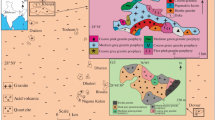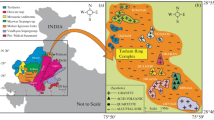Abstract
This paper discusses the geochemical and petrological characteristics of acid volcano-plutonic suite of rocks exposed in Riwasa and Nigana areas of Malani Igneous Suite (MIS), Northwestern India. Geochemically, these acidic rocks having peraluminous and alkalic to alkali-calcic nature and classified as volcanic phase (Riwasa rhyolites), plutonic phase (Nigana granites) and dyke phase (micro-granites). Petrographically, rhyolites show porphyritic, granophyric, glomeroporphyritic, aphyritic, spherulitic and perlitic textures whereas granites show hypidomorphic, granophyric and microgranophyric textures. They are high in silica, A/CNK, total alkalis, Fe/Mg, Ga/Al, Zr, Rb, U, Th, Cu, REEs (except Eu) and low in CaO, MgO, Sc, Cr, Ni, Sr and Eu abundances, which have affinity with A-type granitoids. Their chemistry also support that they are high heat production (HHP) granitoids and their crustal origin. The enrichment of trace elements indicates a genetic link between fractional crystallization of silicate minerals and post magmatic fluid alterations in magmatic chamber. Negative anomalies of Ti, P, Sr and Eu in the multi-element spider diagrams indicate that the emplacement of these granites and associated acid volcanics were controlled by fractionation of feldspar (alkali and plagioclase) and crustal contamination in the magmatic melt arise upward. Normative values of silicate oxides further suggests that these rocks are formed between 2–7 kb pressure ranges and may be emplaced from shallow to greater depth ranges (15–30 km and 450–900°C). Furthermore, geochemical features in acidic rocks such as strong linear positive correlation between LREE, Zr, Nb, Ga, Y and Rb emphasize that the behavior and enrichment of these elements are largely controlled by post-magmatic processes in plume related associations. Hence, the geochemical data presented here, are therefore consistent with an intraplate, co-magmatic and A2-subtype granite field emplaced in extensional tectonic regime of MIS.












Similar content being viewed by others
REFERENCES
J. L. Anderson, “Mineral equilibria and crystallization conditions in the late Precambrian Wolf River Rapakivi Massif, Wisconsin,” J. Am. Sci. 280, 289–332 (1980).
B. Barbarin, “A review of the relationships between granitoid types, their origins and their geodynamic environments,” Lithos, 46, 605–626 (1999).
R. A. Batchelor and P. Bowden, “Petrogenetic interpretation of granitoid rock series using multicationic parameters,” Chem. Geol. 48, 43–55 (1985).
B. Bonin, “A-type granites and related rocks: evolution of a concept, problems and prospects,” Lithos. 97, 1–29 (2007).
B. Bonin, “From orogenic to anorogenic environments: evidence from associated magmatic episodes,” Schweiz. Mineral. Petrogr. Mitt. 68, 301–311 (1988).
A. F. Buddington, “Granite emplacement with special reference to North America,” Geol. Soc. Am. Bull. 70, 611–747 (1959).
A. K. Chaudhary et al., “Present status of the geochronology of the Precambrian rocks of Rajasthan,” J. Tectonophys. 105, 131–140 (1984).
D. B. Clarke, “Chemical variation in Al2O3–CaO–Na2O–K2O space: controls on the peraluminosity of the South Mountain Batholith,” J. Can. Earth. Sci. 41(7), 785–798 (2004).
W. J. Collins et al., “Nature and origin of A-type granites with particular reference to southeastern Australia,” Contrib. Mineral. Petrol. 80, 189–200 (1982).
K. C. Condie, Mantle Plumes and their Record in Earth History (Cambridge University Press, Cambridge. 2001).
K. G. Cox et al., The Interpretation of Igneous Rocks (Allen & Unwin, London, 1979).
A. R. Crawford and W. Compston, “The age of Vindhyan system of peninsular India,” Quart. Jour. Geol. Soc. London. 175, 351–370 (1970).
S. Dhar et al., “Sr, Pb and Nd isotope studies and their bearing on the petrogenesis of the Jalor and Siwana complexes, Rajasthan, India,” J. Geol. Soc. India. 48 (2), 151–160 (1996).
C. H. Donaldson and C. M. B. Henderson, “A new interpretation of round embayments in quartz crystals,” Min. Magaz. 52, 27–33 (1988).
G. N. Eby and N. Kochhar, “Geochemistry and petrogenesis of the Malani Igneous Suite, North Peninsular India,” J. Geol. Soc. India. 36 (2), 109–130 (1990).
G. N. Eby, “Chemical subdivision of the A-type granitoids: petrogenetic and tectonic implications,” J. Geol. 20, 641–644 (1992).
M. M. El. Dabe, “A geochemical tectonomagmatic classification of the A–type granitoids based on their magma types and tectonic regimes,” J. Arab. Geosci. 8, 187–193 (2015).
Kh. M. Fawzy, “Characterization of a post orogenic A–type granite, Gabal El Atawi, Central Eastern Desert, Egypt: Geochemical and radioactive perspectives,” J. Geol. 7, 93–117 (2017).
C. D. Frost and B. R. Frost, “Reduced rapakivi–type granites: the tholeiite connection,” Jour. Geol. 25, 647–650 (1997).
C. D. Frost and B. R. Frost, “On Ferroan (A–type) Granitoids: their Compositional Variability and Modes of Origin,” J. Petrol. 52(1), 39–53 (2010).
L. Gopeshwor and G. Vallinayagam, “Petrological and geochemical constraints in the origin and associated mineralization of A-type granite suite of the Dhiran Area, Northwestern Peninsular India,” J. Geosci. 2 (4), 66–80 (2012).
A. V. Grebennikov, “A-type granites and related rocks: petrogenesis and classification,” Russ. Geol. Geophy. 55, 1074–1086 (2014).
R. K. Gupta, “Embayed quartz crystals in Shyok volcanics, Ladakh,” Contemporary Geoscientific Researches in Himalaya 2, 65–68 (1983).
G. N. Hanson and C. H. Langmuir, “Modeling of major elements: In mantle–melt system using trace elements approaches,” Geochim. Cosmochim. Acta. 42, 725–741 (1978).
P. Henderson, “General geochemical properties and abundances of the rare earth elements,” Rare Earth Element Geochemistry (Elsevier, Amsterdam, 1984), pp. 1–31.
M. Isseini et al., “A–type granites from the Pan–African orogenic belt in south–western Chad constrained using geochemistry, Sr–Nd isotopes and U–Pb geochronology,” Lithos. 153, 39–52 (2012).
N. Kochhar, “Malani Igneous Suite: Hot-spot magmatism and cratonization of the Northern part of the Indian Shield,” J. Geol. Soc. India. 25, 155–161 (1984a).
N. Kochhar, “Tusham ring complex, Bhiwani district, India,” Proc. Ind. Nat. Sci. Acad. 49 (4), 459–490 (1984b).
N. Kochhar et al., “Rb/Sr age of the Tusham Ring Complex Bhiwani, India,” J. Geol. Soc. India. 26, 216–218 (1985).
N. Kochhar, “The Malani Supercontinent,” Front. Earth. Sci. 120–135 (2015).
D. Konopelko et al., “Hercynian post–collisional A–type granites of the Kokshaal Range, Southern Tien Shan, Kyrgyzstan,” Lithos. 97, 140–160 (2007).
Y. A. Kostitsyn et al., “Trace elements and evolution of granite melt as exemplified by the Raumid Pluton, Southern Pamirs,” Geochem. Int. 45 (10), 971–982 (2007).
N. Kumar and G. Vallinayagam, “Geochemistry and petrogenesis of Neoproterozoic A-type granites at Nakora in the Malani Igneous Suite, Western Rajasthan, India,” J. Chin. Geochem. 31, 221–233 (2012).
S. G. Lee et al., “Geochemical significance of the Rb–Sr, La–Ce and Sm–Nd isotope systems in A-type rocks with REE tetrad patterns and negative Eu and Ce anomalies: the Cretaceous Muamsa and Weolaksan granites, South Korea,” Jour. Chem. Der. Erde. 73, 75–88 (2013).
M. C. Loiselle and D. R. Wones, “Characteristics and origin of anorogenic granites,” Geol. Soc. America. Abstracts. 11, 468 (1979).
M. Lopez-Plaza et al., “Contrasting mantle sources and processes involved in a peri–Gondwanan terrane. A case study of pre–Variscan mafic intrusives from the autochthon of the Central Iberian Zone,” Geol. Soc. Am. Spl. Paper. 423, 297–313 (2007).
A. Maheshwari et al., “Geochemistry and petrogenesis of Siwana peralkaline granites, west of Barmer, Rajasthan, India,” Int. Assoc. Gond. Res. Japan, 4 (1), 87–95 (2001).
P. D. Maniar and P. M. Piccoli, “Tectonic discrimination of granitoids,” J. Geol. Soc. Am. Bull. 101 (5), 635–643 (1989).
A-K. M. Moghazi et al., “Sources of rare–metal–bearing A–type granites from Jabel Sayed Complex, Northern Arabian Shield, Saudi Arabia,” Jour. Asian. Earth. Sci. 107, 244–258 (2015).
A. M. B. Moufti et al., “Geochemistry and petrogenesis of the Ediacaran post–collisional Jabal Al–Hassir ring complex, southern Arabian Shield, Saudi Arabia,” J. Chemie. Erde. 73 (4), 451–467 (2013).
H. S. Pareek, “Petrography and geochemistry of Tusham hill felsic volcanics, Haryana,” Jour. Geol. Soc. India. 27, 254–262 (1986).
J. A. Pearce et al., “Trace element description diagrams for the tectonic interpretation of granitic rocks,” Jour. Petrol. 25, 956–983 (1984).
J. Pl`a Cid et al., “Paleoproterozoic late-orogenic and anorogenic alkaline granitic magmatism from northeast Brazil,” Precamb. Res. 104, 47–75 (2000).
D. L. Roche et al., “A classification of volcanic and plutonic rocks using R1–R2 diagram and major–element analysis–its relationship with current nomenclature,” Chem. Geol. 29, 183–210 (1980).
H. R. Rollinson, Using Geochemical Data: Evaluation, Presentation, Interpretation (Longman–Wileys, New York, 1993).
R. Sharma and N. Kumar, “Petrology and Geochemistry of A-type granites from Khanak and Devsar areas of Bhiwani district, Southwestern Haryana,” J. Geol. Soc. India. 90, 138–146 (2017).
A. K. Singh et al., “Anorogenic acid volcanic rocks in the Kundal area of the Malani Igneous Suite, Northwestern India: Geochemical and petrogenetic studies,” J. Asian. Earth. Sci. 27, 544–557 (2006).
M. Stony, “Trachytic pyroclastic from Agua de volcano, Sao Miquel Azores: evolution of a magma body over 4000 years”, Contrib. Mineral. Petrol. 12, 423–432 (1981).
S. S. Sun and W. F. McDonough, “Chemical and isotopic systematics of oceanic basalts: Implications for mantle composition and processes,” Magmatism in the Ocean Basin, Eds. by M. J. Norry and A. D. Saunders, Geol. Soc. Sp. Publ. 2, 313–345 (1989).
W. Wang et al., “Low-δ18O rhyolites from the Malani Igneous Suite: a positive test for south China and NW India linkage in Rodinia,” J. Geophys. Res. 44 (10), 298–305 (2017).
E. B. Watson, “Zircon saturation in felsic liquids: experimental results and applications to trace element geochemistry. Contrib. Miner. Petrol. 70, 407–419 (1979).
J. B. Whalen et al., “A-type granites: Geochemical characteristics, discrimination and petrogenesis,” Contrib. Mineral. Petrol. 96, 407–419 (1987).
ACKNOWLEDGMENTS
The authors wish to express their thanks to Chairman, Department of Geology, Kurukshetra University, Kurukshetra and Director, Wadia Institute of Himalayan Geology, Dehradun for their support. The first author wishes to acknowledge the financial support of the Junior Research Fellowship, University Grand Commission (UGC) to carry out the research work. We are grateful to two journal reviewers for their valuable comments and suggestions to improve the quality of manuscript.
Author information
Authors and Affiliations
Corresponding author
Rights and permissions
About this article
Cite this article
Naveen Kumar, Kumar, N. & Singh, A.K. Petrology and Geochemistry of Acid Volcano-Plutonic Rocks from Riwasa and Nigana Areas of Neoproterozoic Malani Igneous Suite, Northwestern Peninsular India: An Understanding Approach to Magmatic Evolution. Geochem. Int. 57, 645–667 (2019). https://doi.org/10.1134/S001670291906003X
Received:
Revised:
Accepted:
Published:
Issue Date:
DOI: https://doi.org/10.1134/S001670291906003X




